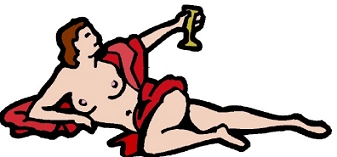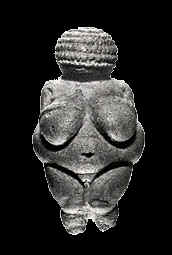A few highlights of the history of research on bras and breast disease:
1. In the 1930s a paper was published making a connection between corsets and increased breast cancer rates.
2. 1978 An M.D. in California pubished an article in a medical journal linking bras with elevated breast temperature, and he suggested that this might have a connection with breast cancer. He studied several hundred women in a medical practice and also observed that the heavier the bra material, the hotter the breast, and that bra-free women of all sizes had cooler breasts. (The Lancet, November 4, 1978, P. 1001 Dr. John M. Douglass, Department of Internal Medicine, S. Calif. Permanente Med. Center Los Angeles, California) see also item #8 for more about breast temperature.
3. 1991 Researchers at Harvard University publish a medical journal article on breast cancer risk. As a side issue of their paper, they mention that the women in their study that did not wear bras had a 60% lower rate of breast cancer than the women who wore bras. (Hsieh, C.C. and D. Trichopoulos, D. Eur. J. Cancer 27:131-5, 1991 "Breast size, handedness and breast cancer risk")
4. 1991 Researchers in Japan pubished a study on bras and sagging, in which they proved that a bra can actually increase breast sagging, rather than the opposite. This effect was most noticeable in larger breasted women. They compared bras to foot binding in their discussion section. ("Breast Form Changes Resulting From A Certain Brassiere" Journal of Hum. Ergol.(Tokyo) 1990 Jun; 19(1):53-62. Ashizawa K, Sugane A, Gunji T Institute of Human Living Sciences, Otsuma Women's University, Tokyo, Japan)
5. 1995 Sydney Singer and Soma Grismaijer of the Institute for the Study of Culturogenic Disease published their book, "Dressed to Kill: The Link Between Breast Cancer and Bras," (Avery Press). Their study included almost 4600 women, half of whom had breast cancer and half of whom did not. They found that the more hours per day that a bra is worn, the higher the rate of breast cancer and that women who do not wear bras have a dramatically reduced rate of breast cancer. Singer and Grismaijer have a website at: http://www.selfstudycenter.org/
6. 1995 through the present. Many women, who had concerns about breast cancer risk and/or breast pain, quit wearing bras and then found that their pain and cysts of fibrocystic breast disease was dramatically decreased or eliminated. Several of these women wrote their own personal case histories, which appear on the web at: http://www.all-natural.com/fibrocys.html
7. May 1999. A landmark study was published in the prestigious British medical journal, The Lancet. This study showed that pre-menopausal women with fibrocystic breast disease have an almost 6-fold higher risk of future breast cancer. This study firmly refutes the advice of some doctors who have said that fibrocystic carries no increased risk. In all, there are now over 30 published medical and scientific research articles showing a connection between fibrocystic and increased breast cancer risk. (Lancet 1999 May 22;353(9166):1742-5 "Risk of breast cancer in women with palpable breast cysts: a prospective study." Edinburgh Breast Group. Dixon JM, McDonald C, Elton RA, Miller WR Edinburgh Breast Unit, Western General Hospital, UK.")
8. 2000. Two British breast surgeons conduct clinical trials at two breast clinics in England and Wales. They study 100 women to see if going brafree (a more positive term the physicians used for braless) could lessen breast pain. Their study concluded that the majority of pre-menopausal women found decreased pain during a three-month bra-free study period. The women were instructed to not wear a bra for three months, and instead to wear a loose and non-restricting camisole if they desired an alternative undergarment. For comparison, they then returned to wearing bras for the another three months. For additional study control, another group of women did the reverse and were bra-wearers for three months, then bra-free for three months. A half-hour documentary was filmed in conjunction with the studies and was shown on nationwide television in England in November, 2000 on Channel 4 UK. Several of the women were interviewed and discussed the life-altering improvements in their breast health, such as being able to now pick up their children or hug their spouse without pain. (Simon Cawthorne, M.D. surgeon at Frenchay Hospital, Bristol, England and Prof. Robert Mansel, M.D., Surgery Dept. Head, University of Wales Medical School, Cardif, Wales.) Doctors interviewed in the film commented about how breasts in bras are hotter than bra-free breasts and the possible connection of this breast heating with breast cancer. Prof. Hugh Simpson discussed his published research, which has previously proven that pre-cancerous and cancerous breasts are both hotter than normal breasts. The documentary included video thermography of women with and without bras, proving that bras cause localized heating of breast tissue.
9. 2000. A group of researchers in Japan published their studies showing that wearing a girdle and bra lowers the levels of the hormone melatonin by 60 percent. (Chronobiol Int 2000 Nov;17(6):783-93 "The effects of skin pressure by clothing on circadian rhythms of core temperature and salivary melatonin." Lee YA, Hyun KJ, Tokura H, Department of Environmental Health, Nara Women's University, Japan.) Melatonin is intimately involved with sleep cycles and is used to prevent jet-lag. Numerous published studies have suggested that melatonin has anti-cancer activities, that it is an antioxidant and can prevent DNA damage, and that it is intimately involved in the immune system and can bind directly to T helper cells. Researchers in Spain have published an article outlining the possible use of melatonin in breast cancer prevention and treatment (Histol Histopathol 2000 Apr;15(2):637-47). Recent research (J. Hansen, "Light at Night, Shiftwork, and Breast Cancer Risk" J Natl Cancer Inst 2001; 93: 1513-1515) has shown that nighttime exposure to light is associated with increased rates of breast cancer. This builds upon previous research that showed that light at night suppresses melatonin production.
10. December 2000. A medical doctor published his findings on shoulder pain treatment in women with large breasts. In this five-year study, it was suggested that patients remove the weight from their shoulders for a period of two weeks, either by going braless or by wearing a strapless bra. Only one woman chose a strapless bra and all the others went braless. quoting the article, "Long-term outcome was presence or absence of muscle pain and tenderness. Seventy-nine percent of patients decided to remove breast weight from the shoulder permanently because it rendered them symptom free." (Ryan, EL, Clin J Pain 2000 Dec;16(4):298-303, "Pectoral girdle myalgia in women: a 5-year study in a clinical setting.")
Breast Cancer? Breast Health!
The Wise Woman Way
by Susun S. Weed
Foreword by Christiane Northrup, MD
380 pages, index, profusely illustrated.
Foods, exercises, and attitudes to keep your breasts healthy. Supportive complimentary medicines to ease side-effects of surgery, radiation, chemotherapy, or tamoxifen.
Retails for $21.95
Read a ReviewRead some excerpts:
Mammograms - Who Needs Them? from Breast Cancer? Breast Health!
Using Herbs Safely from Breast Cancer? Breast Health!
My Anti-Cancer Lifestyle from Breast Cancer? Breast Health!
Order BREAST CANCER? BREAST HEALTH! in our Bookshop
What a gift to women of all ages! This book helped me overcome my fear of what I might discover during self-examination. I am so grateful that this book came my way and I am healthier in mind, body, and spirit thanks to Ms. Weed's wise words! If I could, I would give a copy of this book to every woman in the world!
Breast Cancer? Breast Health! the Wise Woman Way http://www.breasthealthcancerprevention.com/
"Here is the information and spirit that that our hearts and breasts have needed for a very long time." - Christiane Northrup, M.D.
This website is a virtual journey through Breast Cancer? Breast Health! the Wise Woman Way by Susun S. Weed. This invaluable book is for women who want to maintain breast health and for women diagnosed with breast cancer. This information is shared with understanding that you accept complete responsibility for your own health and well-being. Explore and enjoy!
some Articles from the Breast Health website:
VISIT our BREAST HEALTH Website
THANK YOU for VISITING: www.susunweed.com
© Susun Weed -Wise Woman Center ~ Disclaimer & Privacy Policy ~



